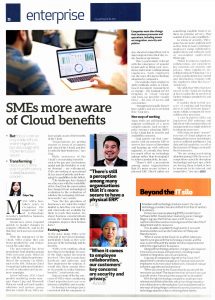Focus Malaysia featured an interview of Microsoft Malaysia and Epicore Software in an industry story discussing the SME landscape, technology adoption among SMEs, their key concerns.
SMEs more aware of Cloud benefits
- But focus is not on only trade-offs to online migration, but also usage and implementation issues
- Transforming IT resources from a cost to profit centre is a key business concern
MANY SMEs have taken years to recognise the important role of technology in today’s borderless business environment.
Businesses must respond quickly to market changes to compete effectively, and to do that, they need access to real-time data.
With the emergence of the Cloud, SMEs realise they can boost productivity and reduce cost at the same time.
The government has been promoting Cloud adoption among SMEs in recent years. This is in line with the digital transformation of the economy via efforts such as the MSC Malaysia Cloud Computing Enablement Initiative as well as education and awareness campaigns.
Epicor Software APAC Cloud product marketing senior manager Roger Ling and Microsoft Malaysia small and mid-market solutions and partner group director Azizah All say SMEs are increasingly aware of the benefits of the Cloud.
“Organisations are getting smarter in terms of awareness and value [of the Cloud], and how it works for their businesses,” says Ling.
While awareness of the Cloud’s overarching benefits such as the pay-per-use business model and the flexibility to scale on demand – are widespread, SMEs are looking at operational fit, key areas of priority and leveraging its capabilities to the fullest. “The landscape has changed over the
 “The landscape has changed over the years with the availability of the Cloud, but the conversation has changed from technological evaluation to the evaluation of whether the technology fits business needs,” says Azizah.
“The landscape has changed over the years with the availability of the Cloud, but the conversation has changed from technological evaluation to the evaluation of whether the technology fits business needs,” says Azizah.
“Now the key questions of businesses are what the target market is, how they can reach it, and what tools arc available for them to reach that market. It’s about business considerations on how the Cloud can help their companies improve their bottom lines.”
Evolving needs
In the past, many SMEs were reluctant to invest in technology, particularly Cloud. as they were unaware of the technology and its benefits.
“SMEs were cautious about investing in technology because of the high capital investment invoked. They had to purchase hardware and software, and then implement the solution. It would take them around three to six months to realise business benefits,” Azizah points out.
Ling says some of the key concerns of SMEs when considering Cloud migration last year were internet availability and security.
Technology is no longer just a convenient tool for companies to stay ahead of competition, but is also integrated into their day-today business operations.
This is particularly relevant with the emergence of popular trends such as bring-your-own-device and remote working among employees. Such employees are the ones driving technology adoption by companies. Lor example, many employees shift workloads online to Cloud-based document management or storage file-hosting service Dropbox or (lloud storage and back-up provider Google Drive – for ease of access and convenience. “Management usually doesn’t have a policy, and users are doing
For example, many employees shift workloads online to Cloud-based document management or storage – file-hosting service Dropbox or Cloud storage and back-up provider Google Drive – for ease of access and convenience.
“Management usually doesn’t have a policy, and users are doing this.” Ling says.
New ways of working Many SMEs are still hesitant to migrate workloads of a more complex nature, such as enterprise resource planning (ERP), to the Cloud due to security and
Many SMEs are still hesitant to migrate workloads of a more complex nature, such as enterprise resource planning (ERP), to the Cloud due to security and availability concerns.
Ling points out that companies with on-premise ERP or servers face issues of downtime and keeping up with software upgrades. As a result, they focus too much effort on technology upkeep rather than leveraging it to achieve productivity, he says.
“There’s still a perception among main organisations that it’s more secure to have a physical ERP, They’d rather see something tangible hosted on their on-premise servers. That comfort level is a key roadblock.”
In terms of security, SMEs’ concerns are more sophisticated as they look at issues relating to employees using collaborative applications and software such as messaging application Whats App.
“When it comes to employee collaboration, our customers’ key concerns are security and privacy. Many employees arc collaborating on WhatsApp. (As a result), organisations lose control and information remains with the employees when they leave.” Azizah says.
She adds that SMEs that have moved to the Cloud are looking at how to subscribe to services to further enhance productivity and outcome.
It enables them to find new ways of working and breaking down of walls between departments within a company for more collaborative processes.
A case in point is SMEs can implement ERP solutions and link them with customer life cycle management on a single platform to integrate processes. SMEs that are more “mature” in terms of Cloud adoption are looking at how newer technologies such as artificial intelligence, big data and data analytics, as well as the Internet of Things can
SMEs that are more “mature” in terms of Cloud adoption are looking at how newer technologies such as artificial intelligence, big data and data analytics, as well as the Internet of Things can benefit their businesses.
“We are seeing accelerating adoption among SMEs because of competition caused by disruption (technology)and start-ups, which are forcing them to look at how to innovate to be relevant and competitive,” she says.


